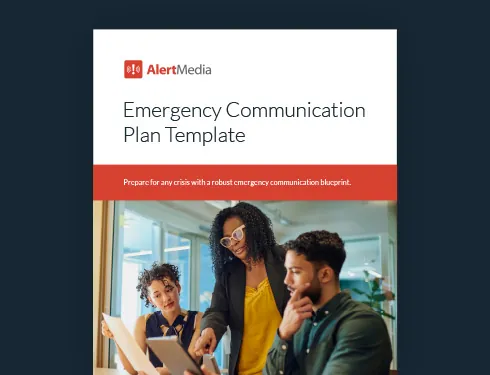
5 Steps to a Comprehensive Emergency Communication Plan
Preparing for an emergency requires a strong emergency communications plan. Learn how to respond with confidence when a critical event arises.

It only takes a few seconds for an emergency to occur. When a critical event arises, you must be able to respond immediately with confidence. If not, things can get out of control, putting your people and business at risk.
An American lumber company experienced this firsthand when a fire broke out in their Madras, Oregon, plant. It took only a few stray sparks to put the entire factory and 20–30 workers in harm’s way. If there had been even a minute’s delay in communication, the plant full of flammable lumber may have faced an extreme catastrophe.
Luckily, the company was prepared. Leaders immediately notified employees to evacuate and called the fire department to extinguish the flames. But their communication planning didn’t stop there. The company was also able to call a truck that had recently departed the factory to have it return so they could check for stray hot embers in the shipment of bark dust.
This company had a comprehensive plan to communicate critical information during a crisis.
While your business may not face the same types of emergencies as a lumber plant, the need to communicate effectively is universal so employees know what’s going on and how to respond. It’s never too early to develop an emergency communication plan. Don’t wait until it’s too late.
Emergency Communication Plan Template
5 Steps to an Emergency Communication Plan |

What Is an Emergency Communications Plan?
An emergency communications plan is a strategic, step-by-step process that specifies when, how, and with whom your business will communicate when an emergency occurs. This plan should cover all the different communication channels and who is in charge of sending messages. The plan should be broad enough to apply to most emergency situations but specific enough for everyone to follow.
When a crisis hits, you’ll have all the information you need to reach your employees and key stakeholders: contact information, addresses, emergency contacts/family members’ phone numbers, and any additional information that will help you keep them safe.
How to Build an Emergency Preparedness Communication Plan
1. Understand your company and its people
When implementing an emergency management plan, it’s critical to communicate relevant, accurate information before, during, and after an incident to the applicable stakeholders. One-size-fits-all messaging doesn’t cut it in times of crisis. Instead, you need custom communication for your security team, remote employees, C-level executives, and your company at large.
For example, following a network cyberattack, you would provide your cybersecurity team with specific information about the attack. This will help them mitigate the risk of data loss and get your network back up and running quickly.
You would also need to send out notifications to the company at large with vital information like what systems were compromised, what information was at risk, what systems like email or internet are down, and whether they would need to change any login credentials.
2. Form an emergency communications team
Depending on the size of your organization, you’ll need someone or a team dedicated to managing your critical communication strategy, info dissemination, and after-action reporting. Assign people to specific roles and responsibilities. Here are a few examples:
- Group admins — These people would be responsible for messaging their specific employee groups.
- Emergency responders — These people would respond to the emergency at hand and relay information to relevant groups.
- Information officers — These people would distribute information to admins and/or update an event page.
- Spokespersons — These people would be responsible for communicating with the public or news media about the event.
If your organization is small, assign someone to manage emergency preparedness and communications. If your organization is large, identify someone who’s part of a broader incident management team and assign them to plan and carry out emergency communications.
 3. Coordinate crisis communication planning
3. Coordinate crisis communication planning
The best time to create or update your emergency communication plans is when you are addressing your broader emergency response plans. As you’re considering the steps to ensure safety and business continuity for any given crisis, you’ll be able to identify the necessary communication steps to make the response possible.
Download our Emergency Response Plan Template to guide your planning process.
Coordinate with everyone who needs to be involved in the communication plan. This includes management and anyone else responsible for employees’ safety and operational continuity. Review plans with your crisis management team or seek help from a business continuity consultant.
Every individual who will be involved needs to understand their role and what will be expected of them. The people who own the emergency communication plan must commit to maintaining it: They should review plans, update them frequently, and execute them in regular emergency drills. This will ensure your organization is prepared for an emergency and your employee contact data is accurate.
4. Script messages ahead of time
Effective emergency communication templates should play a key role in your emergency communications planning. Think through how you should communicate particular incidents to audiences through different communication mediums: text, email, voice, etc. Each incident will affect your personnel and operations in different ways—from natural disasters and severe weather to violence to supply chain disruptions to public health crises.
So, develop precise and tactical messaging to help support your emergency response for each potential critical event. Keep these notification templates short and easy to understand. Focus your message on relevant content and cater it to each audience.
Sample emergency notification templates
Text message notification for an outage
IMPORTANT: A [POWER/NETWORK] outage has occurred at [LOCATION]. Our team is working on resolving it as quickly as possible. For the latest updates and additional resources, visit our event page.
Email notification template for a fire drill
A fire drill will be conducted for all personnel in the [LOCATION] office on [DATE] at approximately [TIME]. Remain calm. This is only a drill.
Upon hearing the fire alarm, please exit the building quickly and calmly, avoid elevators, stay back from entrances once outside, and proceed to the designated assembly area. The entire drill should last approximately 30 minutes. Thank you for your cooperation and participation in this important safety matter. Contact [CONTACT NAME AND PHONE] with any questions or concerns.
Build these templates for all the different kinds of emergencies your business may face so you can quickly send them when the time comes.
5. Invest in emergency communication and threat monitoring technology
To protect your organization and your employees, you need to make sure the right information gets to the right people. The best way to do this is to incorporate an emergency mass notification software into your strategy. Mass notification systems enable you to efficiently distribute emergency information to all parties involved or affected by the event. Ensure your emergency communication system supports two-way communication—so you can account for your people during and after an emergency and even gather critical details about an active event from people at the center of it.
In addition, you can use your emergency notification system to create hierarchies and group people based on role, department, location, employee shift, and any other criteria that matter to your organization. This means you will have quick access to notifying the affected audience at the correct time if an incident arises.
But in order to send helpful, potentially life-saving information, you need to be able to monitor a threat as it emerges. This capability allows your organization to take a proactive approach to employee safety.
A threat monitoring system, like AlertMedia’s, uses real-time data from thousands of trusted sources like government officials, national agencies such as FEMA, social media, and media outlets. Additionally, analysts around the globe provide you with relevant, verified information about wide-ranging threats—from hurricanes and wildfires to political upheavals and transportation disruptions. Best of all, a threat monitoring system will proactively warn you if a threat emerges that could impact your people or locations.
Reach your people through all communication channels
A modern emergency notification system empowers your organization to keep everyone connected during critical events. From anywhere and on any device, you can access the system and reach your people over any channel: text, email, phone call via cell phone or landline, social media, desktop alerts, and even custom channels like Slack and Microsoft Teams. Above all, your system must be flexible so your team can adapt and respond to events as they evolve, using the technology to keep stakeholders updated as events unfold and get resolved.
Test your systems
At least every quarter, run tests of your communication system to ensure the technology is working as expected and there are no gaps in your data. Testing can work in tandem with training because as you expose employees to the communication process, notification types, and expectations for their response, you also run your employee notification system, segmentation, and contact information through the motions to identify failures in a low-risk scenario.
Train Your Team to Deploy an Emergency Communication Plan
At this point, you have a substantial emergency communication plan built to mitigate your business risks and protect your people—but it’s still just a plan. You’ve taken the time to identify communication team leaders. Begin by training them to execute the plan and adapt to unforeseen developments.
With these leaders up to speed, company-wide training can be a collaborative effort. All employees need to understand
- Why emergency notifications are being sent
- Who is sending notifications, and how employees know to trust the sender
- How various communication channels work and how to activate notifications on their devices
- How to read messages and reply to them, if required
- How to act in support of the organization’s emergency response
Training should involve test notifications, so everyone gets hands-on practice—both those receiving the messages and those sending them. It’s also important to remember that all businesses are unique; an emergency for one business may not concern another. Establish guidelines for what constitutes an emergency and when to execute your response plan and emergency alerts. Being transparent about these guidelines with your employees also helps them understand that they should take any notifications seriously because the communication plan is deployed only for true emergencies.
It’s also important to remember that all businesses are unique; an emergency for one business may not concern another. Establish guidelines for what constitutes an emergency and when to execute your response plan and emergency alerts. Being transparent about these guidelines with your employees also helps them understand that they should take any notifications seriously because the communication plan is deployed only for true emergencies.
Choose Proactive Communication Preparedness
“You can take any after-action report, and nine times out of ten, a lack of communication will be on there [as an underlying issue]. Communication is critical because it saves time, allows us to make the correct decisions, and prevents us from backpedaling.” We learned this from two safety leaders at Valley View Hospital—Josh Anderson, Manager of Safety, Security, and Emergency Management, and Stacey Gavrell, Chief Community Relations Officer. “With the tools we have in place now, communication is showing up less and less in our after-action reports.”
The worst-case scenario is to find out the hard way that your communication preparedness falls short. Build and coordinate a strong emergency communication plan now—when you can carefully consider who needs to be involved and how, what tools you need to have in place, and what contingencies you need to plan for.




